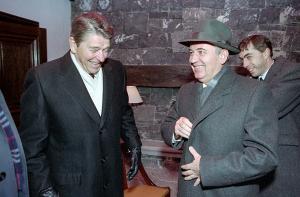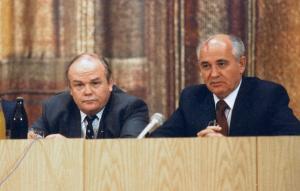ITER is part of his legacy
Mikhail Sergeyevich Gorbachev, who passed away on 30 August 2022 at age 91, was instrumental in the decision to launch the international collaboration in fusion that would soon be known as "ITER." Much younger than his predecessors when he acceded to the top position of General Secretary of the Communist Party of the USSR in March 1985, the new leader saw the world with different eyes. Rather than pursuing the ruinous arms race of the Cold War, he wanted, and needed, collaboration with the West.
When he met with US President Ronald Reagan in Geneva, in November of that same year, the items in their agenda all revolved around the easing of tensions between the two blocs. The joint statement that was issued at the close of their meeting listed them all, from the strategic ("a nuclear war cannot be won and must never be fought") to the trivial ("increased television coverage of sports events").
The last item stated that Secretary General Mikhail Gorbachev and President Ronald Reagan "emphasized the potential importance of the work aimed at utilizing controlled thermonuclear fusion for peaceful purposes and, in this connection, advocated the widest practicable development of international cooperation in obtaining this source of energy, which is essentially inexhaustible, for the benefit of all mankind." In short: let's pull together and build the large machine that will demonstrate the feasibility of fusion.
How did Gorbachev, a law graduate, became a proponent of fusion energy? A friend from his student years at Moscow State University played a decisive role. Evgeny Velikhov, the physicist who had piloted Soviet fusion research since 1973, had long been convinced that progress in this massively challenging field of research would only be achieved through international collaboration. His conviction was shared by his Western colleagues, and soon, by Gorbachev himself.
In an interview he gave to the ITER Newsline in November 2015 on the occasion of the 30th anniversary of the Reagan-Gorbachev summit, Academician Velikhov, who was to head the ITER Council in 1992 and again in 2010-2012, recalled how the international collaboration in fusion made its way onto the agenda at Geneva.
"Soon after Mikhail Gorbachev became the General Secretary [...] he went on his first visit to France to meet President Mitterrand," confided Velikhov. [...] "Two ideas were born then—the first dealt with joint work on an accelerator of the supercollider type, and I decided to propose cooperation in the area of nuclear fusion."
East-West cooperation in fusion was nothing new. Scientists on both sides of the great East-West divide had been communicating and exchanging on research since the late 1950s, and as early as 1973 the United States, the Soviet Union, Europe and Japan had formally engaged in the INTOR (INternational TOkamak Reactor) project, whose concept and organization was very close to what ITER's would be.
However for want of strong political determination, INTOR never reached the design phase. Now, as Gorbachev and Reagan were preparing to meet, the conditions were different. Beyond its importance per se, a large international scientific and industrial collaboration that would open the way to a new energy source "for the benefit of all mankind" made a powerful symbol of the post-Cold War world the two leaders wanted to shape.
At their second meeting in Reykjavik, Iceland, in October 1986, the two leaders reiterated their commitment and officially launched the international fusion initiative. Five months later, a Quadripartite Initiative Committee formed by US, Soviet, European and Japanese representatives decided that the project would be named ITER.



